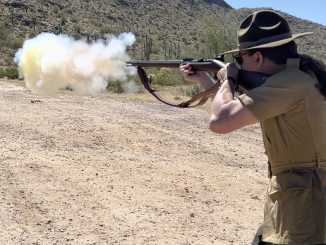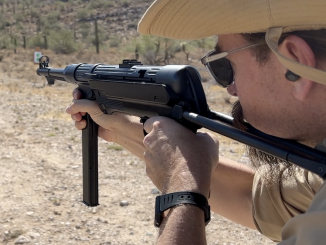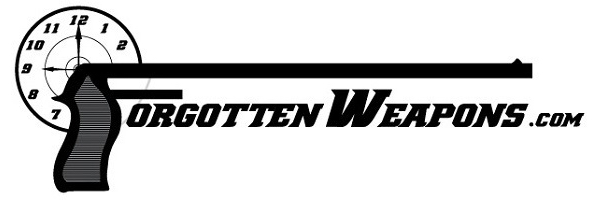The Confederate States of America didn’t have very much capacity for manufacturing small arms, and was happy to purchase guns from anyone who could make them. Among others who got into the gun-making business during the Civil War were the Dance brothers of Texas. They only managed to produce between 325 and 500 guns during the war, but they did have a formal contract from the CSA and their pistols are a bit more distinctive than most Confederate arms. This one stands out in particular with it’s silver star embellishment.
Related Articles

Antiques
Enjoying Black Powder Episode 1: The Trapdoor Springfield
For the full episode with the hand loading instructional section, click here: https://forgottenweapons.vhx.tv/videos/trapdoor-app-cut Black powder military rifles of the 1860s-1880s are a really enjoyable group of guns. A lot of them are relatively reasonably priced, […]

Reproduction
Introducing the BD-38: A New Production Copy of the German MP-38
There has never been a proper semiauto version of the MP40 available in the US, until now. SSD (Sport-Systeme Dittrich) is a German company that has been making semiauto copies of German WW2 small arms […]

Select-fire Rifles
Modern Take on the Sturmgewehr, and a Mile Long Shot to Kill
Two things today… First up, I recently had a chance to tinker with a rifle made by Brethren Arms, which is in many ways the modern evolution of the StG-45 that we looked at in […]

This is bizarre. I have had nothing but Dance revolvers on the brain right now and this article pops up.I had recently bought a Pietta Dance .44 and did a comparison with photos and stats of the real deal. From my “research” I divined (need to be data checked) that the Dragoon Colt was 68 ounces with a 7.5 inch barrels. The .44 Dance weight 54 ounces with an 8 inch barrel. The 8″ barrel compensated apparently for the shorter Dance cylinder and shortened frame so that the two pistols were about the same overall length, they could use the same Dragoon holsters (this is just a guess of course). It can be deduced that the shorter cylinder, shorter frame and the lack of recoil shields that the weight was lost here, so the Dance was probably a bit more nose heavy than the Dragoon…possibly. The original .44 Dance may have been an actual attempt to lighten the Dragoon?
The Pietta .44 Dance is listed at 39 ounces (is this listing accurate, I have not weighed mine) with an 8″ barrel. The 1851 Navy (oringinal) is listed at 42 ounces with 7.5″ barrel. The original .36 Dance was listed at 40 ounces with a 7.5 inch barrel. So I have come to the inevitable conclusion that the .44 Pietta dance is a hybrid…in size is like a .36 Dance, is a bit more muzzle heavy, but the long barrel is more reminiscent of the original .44 and of course the cylinder is .44.
I have not compared a .36 Dance with with the .44 Dance original and it would be fascinating if someone did that today, rather than rely on old conclusions.
They must not have been the one and only company producing firearms for the Confederacy, as there was produced another firearm called the Texas Tyler Rifle.
It would be interesting to know what manufacturing technology was like in that era. One of the Fitefox books went over colonial era gun making, and I have a reasonable grasp of how they were made around the turn of the century. But this era is a mystery to me, what was involved in setting and running an arms factory in that era?
Steam powered over head shafts running lathes and mills? If so, where did the Confederacy import those tools from? Or was it a more labor intensive form of glorified black smithing?
It varied. There were established manufacturers and state arsenals with different degrees of technology available in the antebellum era. Places like the Palmetto Armory in South Carolina and other state-run arsenals had been producing small arms long before secession so the equipment was already in place. Also, The armory at Harper’s Ferry was seized by the state of Virginia early in the war and produced weapons until the war ended. Private manufacturers such as Cook and Brother of New Orleans produced high quality arms until the city fell, then moved their factory to Georgia. Manufacturers such as Griswold and Gunnison went from making cotton gins to revolvers, and such was the case with most other southern manufacturers. There were also the “blacksmith made” pieces, most often conversions, of older flintlock weapons, particularly the Texas Hall conversions, as well as earlier muzzle loading muskets. The Ben Michel collection had numerous examples of these conversions, including a Revolutionary war-era Brown Bess musket found in a Virginia barn. The biggest problem the South faced was a lack of raw materials, particularly quality steel, to produce its own arms in sufficient quantity. That is why many Confederate arms used iron and brass wherever possible, notably the Spiller and Burr revolvers with their iron barrels seated into brass frames. The South was not as technically “backward” as many armchair historians would suggest, but overall they lacked the raw materials and vast manufacturing base of the North. If one looks at the Dance Bros. revolver, the unique design is a result of a need to reduce both material use and manufacturing steps to produce as many as they could in a short period of time.
I recomend L. T. C. Rolt “Tools for the Job”.
Halfway in the book You will find fantastic chapter about manufacturing small arms in the XIX century, and in second or third chapter about gun(artillery) barrels(early boring machines etc.).